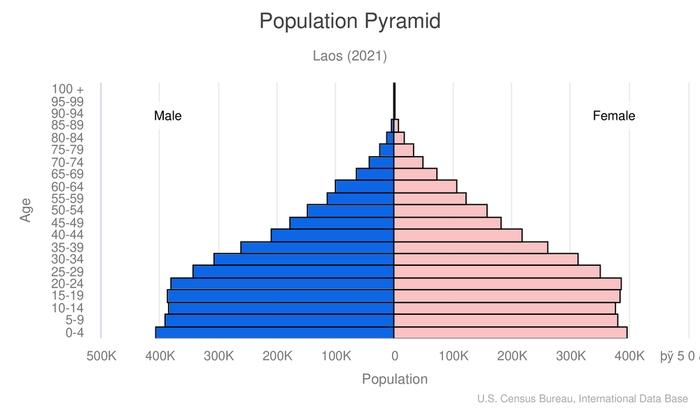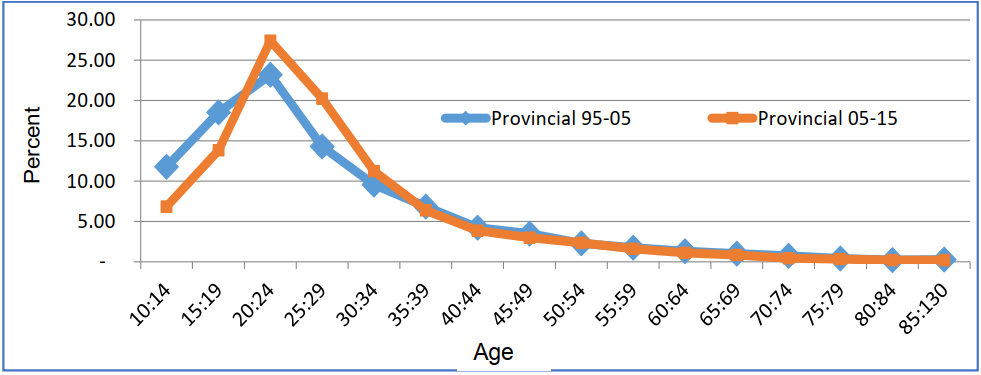Introduction
Understanding population dynamics is the cornerstone of uncovering the economic and cultural development of a country. The Lao People’s Democratic Republic (PDR) is a country in Southeast Asia with an area of approximately 240,000 km2 (McCartney & Brunner, 2020). According to the 2019 data, more than 7 million people lived in Lao PDR, with a population density of 30 persons per km2 and a rate of natural increase or RNI of about 1.5% (Manivong & Cramb, 2020). As shown in Figure 1, Laos’s population is relatively young, with most people being in the age range of 15-34 (Central Intelligence Agency, 2021). Laos is one of the poorest countries in the Southeast Asian region, with 65% of its people being involved in agriculture (McCartney & Brunner, 2020). This country’s economy has improved significantly over the last two decades, becoming one of the fastest-growing economies in the region (Goto & Douangngeune, 2017). Rapid economic growth can be partially attributed to population migration and urbanization. Low income from agriculture and poor quality of education in rural areas forces Laotians to migrate to bigger cities, but the economy will improve only when the government will support internal migration and immigration.

Main Reasons for Migration
Migration from rural to urban areas has always been thought to improve living conditions and increase income. There are positive and negative reasons for people to leave rural areas. Positive reasons are mainly related to growth in the number of workplaces in industry, construction, tourism, and transportation. Negative reasons or forces that drive migration include poverty, the land deficit in rural areas, natural disasters, which are all the results of government policies aimed at industrialization and improvement of the country’s infrastructure by forcing peasants’ resettlement (McCartney & Brunner, 2020). Undoubtedly, migration to cities drives economic growth and creates opportunities for better education and better income. However, Lao PDR’s government needs to provide more support to migrants from rural areas to ensure they have the same healthcare, education, and employment opportunities as urban citizens.
Consequences of Urbanization
Laos is a mainly agricultural society with growing tendencies to inter-provincial migration. According to Insisienmay and Philavanh (2019), the net migration rates from rural areas to the cities were highest to Vientiane Capital. Urbanization in Laos increased twofold in ten years, as shown in Figures 2 and 3 (Vongpraseuth, 2020). There are five most populated cities in Laos: Vientiane Capital, Pakse, Savannakhet, Luang Prabang, and Xam Nua (Lao Statistics Bureau, 2019). Most of these cities have favorable locations across the Mekong River, ensuring access to water for farmers in the neighboring areas and factories in the cities. However, the Mekong River’s water overuse and pollution caused a massive natural disaster that severely affected agriculture and caused migration to different provinces.


For centuries, people in Laos were relying on fishing and agriculture using the Mekong River water. Although such natural disasters as droughts and floods have always been affecting farming, it appears that industrialization created environmental problems that reduced rice production. For example, extensive dam construction and water pollution from mining aggravated damage from floods and droughts, resulting in significant financial losses in the agrarian sector (McCartney & Brunner, 2020). This damage affects farmers and their families by depriving them of food and income. Furthermore, considering recent rice export growth with a value of about USD 40 million, the Mekong River’s water mismanagement may also affect the country’s economic growth (Manivong & Cramb, 2020). Therefore, this problem should become one of the priorities for the government of Lao PDR.
Education and Employment as Drivers for Population Migration
One of the main reasons for most young Laotians to move to the cities is to receive a good education. In the 1970s, the Lao People’s Revolutionary Party’s goal was to eradicate illiteracy and revolutionize Laos’ education (Creak, 2018). Although the illiteracy eradication reform targeted almost 100% of the population, literacy rates are only slightly higher than 80% (Creak, 2018). However, literacy is not sufficient to find a high-paid job in the modern world. Therefore, many young people in Laos decided to move to the cities to pursue a college education and find a pleasing workplace. The predominance of young people among migrants between provinces is shown in Figure 4 (Insisienmay & Philavanh, 2019). Receiving higher education and acquiring skills creates a broader range of employment opportunities for young people. The difficulties that may arise for people who move to cities are housing problems or mental and physical health problems. Thus, governmental support to students from rural areas is essential.

Another reason for people to migrate from rural areas to urban areas is to seek better employment. As previously mentioned, despite rapid economic growth, Laos, being predominantly agricultural, is still considered a developing country. For example, the average per person monthly income in 2012 was only about USD 75 (Goto & Douangngeune, 2017). Moreover, although Laos’s average life expectancy is 65, Laos’s dependency rate is around 60%, primarily due to the high youth dependency rate (Central Intelligence Agency, 2021). As inferred from the population pyramid in Figure 1, Laos is still in the second stage of the demographic transition model (Central Intelligence Agency, 2021). At this stage, the country has high birth rates, which explains why Laos has a high youth dependency rate. Such a high dependency rate places an increased burden on the working population. Therefore, many working-age people migrate to more industrialized provinces of Laos and, rarely, to the neighboring countries to search for better employment opportunities. Government reforms about strengthening the industrial sector created new workplaces, which provides higher income for migrants from rural areas. However, housing and health problems may arise for workers who moved to the cities recently. These problems may lower the efficiency of workers, which affects the overall productivity of industrial enterprises.
The Laos government had started modernization reforms in industrial and agricultural sectors after gaining independence in 1975. Industrial advancement propelled forward economic development of Laos and reduced unemployment. For example, opening about 40,000 factories allowed 135,000 new workplaces in 2012 (Phonsavath, 2017). The government focused on shifting farming to “intensification and commercialization” (Goto & Douangngeune, 2017, p.15). Although rice export raised, the proportion of agricultural export constitutes only 5% of the total export (Manivong & Cramb, 2020). There are three possible reasons why the farming sector, comprising a more significant part of Laos economy, remains at the level of subsistence. First, the intensification of industrialization shifted the central workforce to the cities. Second, urbanization and industrial growth caused water and soil pollution, reducing yield growth rates (Goto & Douangngeune, 2017). Third, funding of the agricultural sector is insufficient. According to Goto and Douangngeune (2017), lack of finances and technical knowledge in irrigation is the second main obstacle after lack of workers. Migration to the cities brings more workforce to industry, but out-migration from rural areas causes a lack of workers in the agricultural sector.
Out-Migration Concerns and Problems with Immigration
The gradual increase in Laos’s urban population might create an opportunity to switch from a predominantly agricultural to an industrial economy in the future. As it has been mentioned above, the agricultural sector suffers from a lack of workers. The lack of workers in the farming sector resulted from the shift of the central workforce to the industry, suggesting that Laos became a more industrialized country. However, the problem is that most of the population is still involved in agriculture (McCartney & Brunner, 2020). Therefore, the idea of switching Laos to an industrial empire is premature. Certainly, industrialization itself, which caused the out-migration of workers from rural areas, is probably not the problem. Conversely, migration to cities resulted in an 8% increase in population income, which means that continuous inflow of workforce will benefit the industrial sector (Insisienmay & Philavanh, 2019). However, before Laos economy becomes mainly industry-driven, the government needs to resolve the issue of the lack of workers in the agricultural sector. One possible solution can be to encourage receiving education and expertise in irrigation and agriculture to bring more qualified workers to this sector. The government of Laos should consider introducing some additional educational reforms.
Increasing access to higher education and supporting research will benefit the economy of Laos. As discussed previously, receiving higher education is one of the major driving forces for young people to migrate from rural areas to the cities. Encouraging education and research has always been considered one of the principal contributors to economic growth because educated experts utilize their knowledge of agriculture and industry, enabling improvement and enhancement of these sectors (Creak & Barney, 2018). However, access to higher education and research is still limited and often strictly censored in this country (Creak & Barney, 2018). Many research areas are restricted or unavailable. Moreover, collaboration with international researchers is limited too. Immigration to Lao PDR has complicated visa policies for foreign scientists (Creak & Barney, 2018). Internal migration within Laos is encouraged by government policies related to the enhancement of the industrial sector. However, educators, scientists, experts, and investors’ immigration to Laos is complicated by the strict visa rules. Therefore, education and research in Laos are lagging, which significantly diminishes the country’s economic growth. To facilitate the country’s economic development, Laos’s government should reconsider strict immigration rules and simplify obtaining foreign experts and researchers’ visas.
Conclusion
Overall, migration in Laos is gradually increasing from rural areas to the cities. Although Lao PDR is still considered a poor agricultural country, urbanization enables faster economic development. However, urbanization and industrialization create problems for the environment and the agriculture of Laos. People who migrate to the cities pursue higher education and seek better employment opportunities. Laos’s government encourages internal migration by creating more workplaces in the industrial sector, but strict visa policies limit immigration. Encouraging foreign experts’ immigration and supporting workers’ internal migration will help increase the country’s economic growth.
References
Central Intelligence Agency. (2021). Laos. Web.
Creak, S. (2018). Abolishing illiteracy and upgrading culture: adult education and revolutionary hegemony in socialist Laos abolishing illiteracy and upgrading culture: adult education and revolutionary hegemony in socialist Laos. Journal of Contemporary Asia, 48(5), 761-782. Web.
Creak, S., & Barney, K. (2018). Conceptualising party-state governance and rule in Laos. Journal of Contemporary Asia, 48(5), 693–716. Web.
Goto, K., & Douangngeune, B. (2017). Agricultural modernisation and rural livelihood strategies: the case of rice farming in Laos. Canadian Journal of Development Studies/Revue, 5189(4), 467-486. Web.
Insisienmay, S., & Philavanh, S. (2019). Internal migration in Lao PDR (Issue March). Web.
Lao Statistics Bureau. (2019). Population by provinces. Web.
Manivong, V., & Cramb, R. (2020). From subsistence to commercial rice production in Laos. In R. Cramb (Ed.), White Gold: The Commercialisation of Rice Farming in the Lower Mekong Basin (pp. 103–119). Palgrave Macmillan. Web.
McCartney, M., & Brunner, J. (2020). Improved water management is central to solving the water-energy-food trilemma in Lao PDR. International Journal of Water Resources Development, 1–21. Web.
Phonsavath, T. (2017). Sustainable consumption and production in Lao PDR. In P. Schroeder, K. Anggraeni, S. Sartori, & U. Weber (Eds.), Sustainable Asia: Supporting the Transition to Sustainable Consumption and Production in Asian Developing Countries (pp. 183–212). World Scientific Publishing Co. Pte. Ltd.
Vongpraseuth, T. (2020). Reality of urbanization and urban master plan of Vientiane Capital, Lao PDR: Issues and Prospects. American Scientific Research Journal for Engineering, Technology, and Sciences (ASRJETS), 70(1), 1–15. Web.